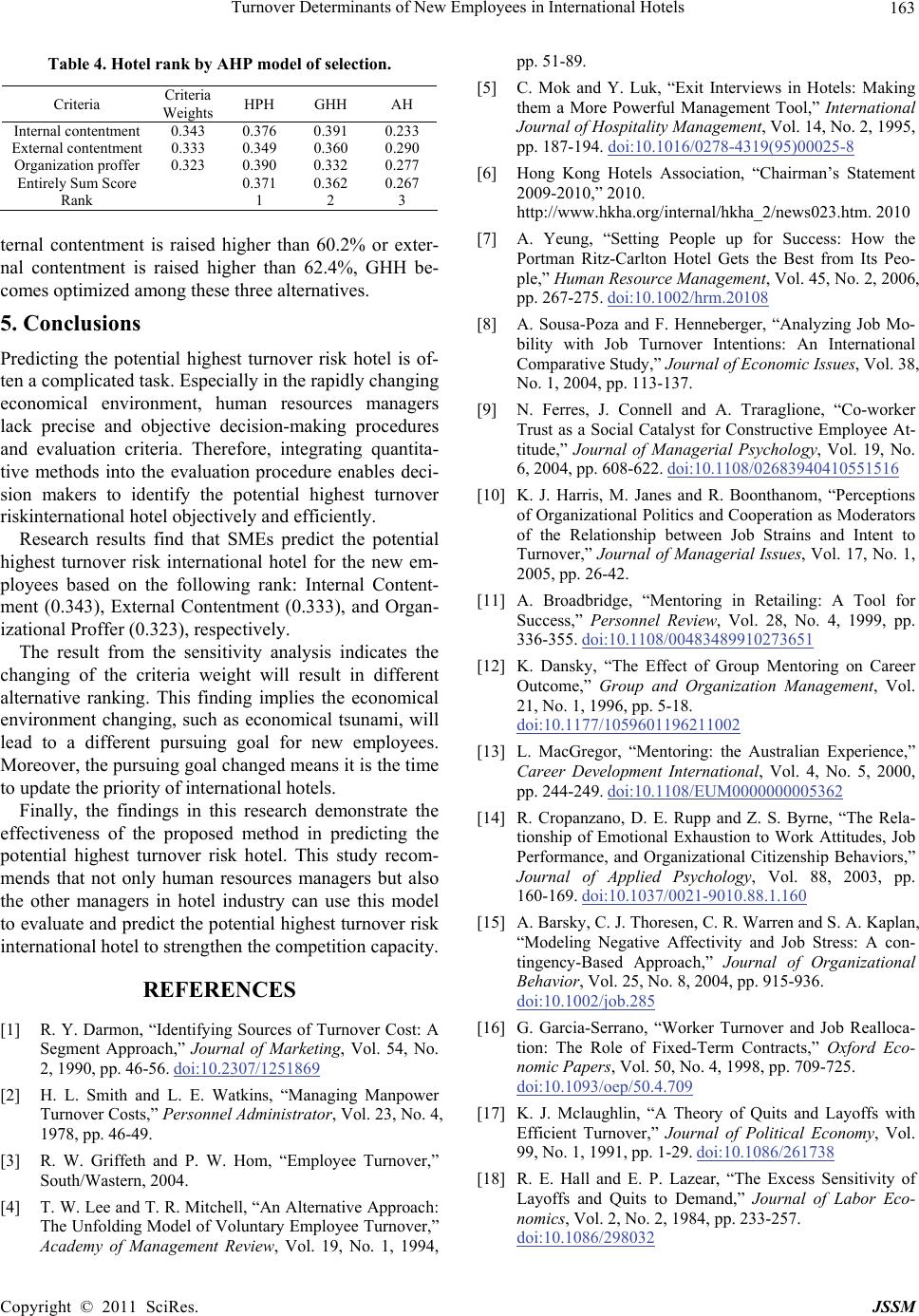
Turnover Determinants of New Employees in International Hotels 163
Table 4. Hotel rank by AHP model of selection.
Criteria Criteria
Weights HPH GHH AH
Internal contentment 0.343 0.376 0.391 0.233
External contentment 0.333 0.349 0.360 0.290
Organization proffer 0.323 0.390 0.332 0.277
Entirely Sum Score 0.371 0.362 0.267
Rank 1 2 3
ternal contentment is raised higher than 60.2% or exter-
nal contentment is raised higher than 62.4%, GHH be-
comes optimized among these three alternatives.
5. Conclusions
Predicting the potential highest turnover risk hotel is of-
ten a complicated task. Especially in the rapidly changing
economical environment, human resources managers
lack precise and objective decision-making procedures
and evaluation criteria. Therefore, integrating quantita-
tive methods into the evaluation procedure enables deci-
sion makers to identify the potential highest turnover
riskinternational ho tel objectively and efficiently.
Research results find that SMEs predict the potential
highest turnover risk international hotel for the new em-
ployees based on the following rank: Internal Content-
ment (0.343), External Contentment (0.333), and Organ-
izational Proffer (0.323), respectively.
The result from the sensitivity analysis indicates the
changing of the criteria weight will result in different
alternative ranking. This finding implies the economical
environment changing, such as economical tsunami, will
lead to a different pursuing goal for new employees.
Moreover, the pursuing goal changed means it is the time
to update the priority of international hotels.
Finally, the findings in this research demonstrate the
effectiveness of the proposed method in predicting the
potential highest turnover risk hotel. This study recom-
mends that not only human resources managers but also
the other managers in hotel industry can use this model
to evaluate and predict th e potential highest turnover risk
international hotel to streng then the competition capacity.
REFERENCES
[1] R. Y. Darmon, “Identifying Sources of Turnover Cost: A
Segment Approach,” Journal of Marketing, Vol. 54, No.
2, 1990, pp. 46-56. doi:10.2307/1251869
[2] H. L. Smith and L. E. Watkins, “Managing Manpower
Turnover Costs,” Personnel Administrator, Vol. 23, No. 4,
1978, pp. 46-49.
[3] R. W. Griffeth and P. W. Hom, “Employee Turnover,”
South/Wastern, 2004.
[4] T. W. Lee and T. R. Mitchell, “An Alte rnative Approach:
The Unfolding Model of Voluntary Employee Turnover,”
Academy of Management Review, Vol. 19, No. 1, 1994,
pp. 51-89.
[5] C. Mok and Y. Luk, “Exit Interviews in Hotels: Making
them a More Powerful Management Tool,” International
Journal of Hospitality Management, Vol. 14, No. 2, 1995,
pp. 187-194. doi:10.1016/0278-4319(95)00025-8
[6] Hong Kong Hotels Association, “Chairman’s Statement
2009-2010,” 2010.
http://www.hkha.org/internal/hkha_2/news023.htm. 2010
[7] A. Yeung, “Setting People up for Success: How the
Portman Ritz-Carlton Hotel Gets the Best from Its Peo-
ple,” Human Resource Management, Vol. 45, No. 2, 2006,
pp. 267-275. doi:10.1002/hrm.20108
[8] A. Sousa-Poza and F. Henneberger, “Analyzing Job Mo-
bility with Job Turnover Intentions: An International
Comparative Study,” Journal of Economic Issues, Vol. 38,
No. 1, 2004, pp. 113-137.
[9] N. Ferres, J. Connell and A. Traraglione, “Co-worker
Trust as a Social Catalyst for Constructive Employee At-
titude,” Journal of Managerial Psychology, Vol. 19, No.
6, 2004, pp. 608-622. doi:10.1108/02683940410551516
[10] K. J. Harris, M. Janes and R. Boonthanom, “Perceptions
of Organizational Politics and Cooperation as Moderators
of the Relationship between Job Strains and Intent to
Turnover,” Journal of Managerial Issues, Vol. 17, No. 1,
2005, pp. 26-42.
[11] A. Broadbridge, “Mentoring in Retailing: A Tool for
Success,” Personnel Review, Vol. 28, No. 4, 1999, pp.
336-355. doi:10.1108/00483489910273651
[12] K. Dansky, “The Effect of Group Mentoring on Career
Outcome,” Group and Organization Management, Vol.
21, No. 1, 1996, pp. 5-18.
doi:10.1177/1059601196211002
[13] L. MacGregor, “Mentoring: the Australian Experience,”
Career Development International, Vol. 4, No. 5, 2000,
pp. 244-249. doi:10.1108/EUM0000000005362
[14] R. Cropanzano, D. E. Rupp and Z. S. Byrne, “The Rela-
tionship of Emotional Exhaustion to Work Attitudes, Job
Performance, and Organizational Citizenship Behaviors,”
Journal of Applied Psychology, Vol. 88, 2003, pp.
160-169. doi:10.1037/0021-9010.88.1.160
[15] A. Barsky, C. J. Thoresen, C. R. Warren and S. A. Kaplan,
“Modeling Negative Affectivity and Job Stress: A con-
tingency-Based Approach,” Journal of Organizational
Behavior, Vol. 25, No. 8, 2004, pp. 915-936.
doi:10.1002/job.285
[16] G. Garcia-Serrano, “Worker Turnover and Job Realloca-
tion: The Role of Fixed-Term Contracts,” Oxford Eco-
nomic Papers, Vol. 50, No. 4, 1998, pp. 709-725.
doi:10.1093/oep/50.4.709
[17] K. J. Mclaughlin, “A Theory of Quits and Layoffs with
Efficient Turnover,” Journal of Political Economy, Vol.
99, No. 1, 1991, pp. 1-29. doi:10.1086/261738
[18] R. E. Hall and E. P. Lazear, “The Excess Sensitivity of
Layoffs and Quits to Demand,” Journal of Labor Eco-
nomics, Vol. 2, No. 2, 1984, pp. 233-257.
doi:10.1086/298032
Copyright © 2011 SciRes. JSSM